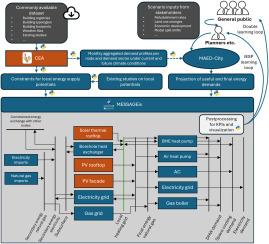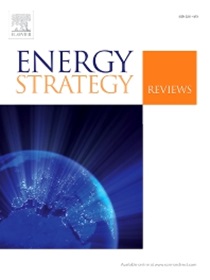Urban energy system modeling as strategic tool for integrated spatial and energy planning: A multi-node, multi-stage optimization approach
IF 7.9
2区 工程技术
Q1 ENERGY & FUELS
引用次数: 0
Abstract
Urban energy system modeling intended to support strategic decision-making in integrated spatial and energy planning must integrate multiple sectors and at high spatio-temporal resolutions to account for the complexities of urban environments. Decision-making must account for spatial constraints, heterogeneity, and uncertainty in socio-economic and technological development trajectories. Few modeling approaches are sufficiently holistic to support such complex planning needs by themselves and modeling tool combinations are often applied case specific. This work contributes to bridging this gap by presenting a novel urban energy system modeling framework (UESMF) that combines spatially resolved, cross-sectoral energy demand projections with techno-economic optimization of energy transition pathways using Linear Programming (LP), while accounting for detailed spatial and temporal constraints of the built environment. The UESMF couples City Energy Analyst (CEA), MAED-City, and MESSAGEix, leveraging their respective strengths. CEA is used for building-level modeling of current useful energy demands in the built environment, MAED-City provides cross-sectoral projections for these energy demands based on their link to socio-economic and technological development pathways, and MESSAGEix delivers techno-economically optimized energy supply capacity investment pathways that correspond to scenario assumptions, local technical constraints, and policy constraints. The novelty lies in the developed streamlined tool coupling, which is implemented via automated Python scrips and allows fast feedback loops for the exploration of different development pathways and planning alternatives. The UESMF is demonstrated through a real urban energy case study, showcasing how it enables the exploration of trade-offs between different planning and policy scenarios.

城市能源系统建模作为空间与能源综合规划的战略工具:一种多节点、多阶段的优化方法
城市能源系统建模旨在支持综合空间和能源规划中的战略决策,必须以高时空分辨率整合多个部门,以考虑城市环境的复杂性。决策必须考虑到社会经济和技术发展轨迹的空间限制、异质性和不确定性。很少有建模方法能够充分全面地支持这种复杂的规划需求,并且建模工具组合通常是特定于案例的。这项工作通过提出一种新的城市能源系统建模框架(UESMF)来弥合这一差距,该框架将空间解决、跨部门的能源需求预测与使用线性规划(LP)的能源转换路径的技术经济优化相结合,同时考虑了建筑环境的详细空间和时间约束。usmf将城市能源分析师(CEA)、MAED-City和MESSAGEix结合在一起,利用各自的优势。CEA用于建筑环境中当前有用能源需求的建筑级建模,MAED-City根据这些能源需求与社会经济和技术发展路径的联系,为这些能源需求提供跨部门预测,MESSAGEix提供技术经济优化的能源供应能力投资路径,与情景假设、当地技术约束和政策约束相对应。新颖之处在于已开发的流线型工具耦合,它通过自动化Python脚本实现,并允许快速反馈循环,用于探索不同的开发路径和规划替代方案。UESMF通过一个真实的城市能源案例研究进行演示,展示了它如何能够探索不同规划和政策情景之间的权衡。
本文章由计算机程序翻译,如有差异,请以英文原文为准。
求助全文
约1分钟内获得全文
求助全文
来源期刊

Energy Strategy Reviews
Energy-Energy (miscellaneous)
CiteScore
12.80
自引率
4.90%
发文量
167
审稿时长
40 weeks
期刊介绍:
Energy Strategy Reviews is a gold open access journal that provides authoritative content on strategic decision-making and vision-sharing related to society''s energy needs.
Energy Strategy Reviews publishes:
• Analyses
• Methodologies
• Case Studies
• Reviews
And by invitation:
• Report Reviews
• Viewpoints
 求助内容:
求助内容: 应助结果提醒方式:
应助结果提醒方式:


